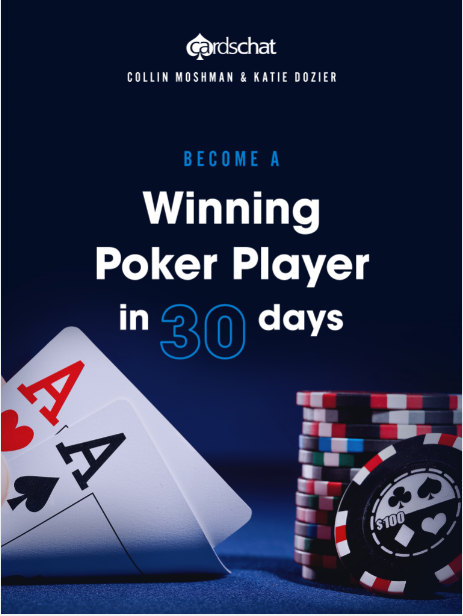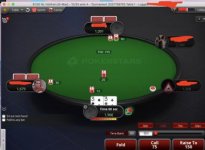You are using an out of date browser. It may not display this or other websites correctly.
You should upgrade or use an alternative browser.
You should upgrade or use an alternative browser.
Katie Dozier
Poker Expert
Silver Level
Thanks for this lesson I learned how to calculate implied odds and I learned so much from this. Thanks
That’s awesome to hear, way to go!
steveeeee
Rock Star
Bronze Level
implied odds are aprox 26 to 1 and yes to callImplied Odds and Reverse Implied Odds are the topic of discussion on Day 9 of our course.
If you have not yet read Day 9 and watched the video for Day 9 - take a few minutes now to do that and then come back here to discuss it:
Implied Odds and Reverse Implied Odds
Implied odds is the ratio of the possible or likely amount we will win relative to the cost of calling. This is a very important concept if you are playing with deep stacks.
Reverse implied odds is having a made hand that's not likely to win us more money when it's best, and can lose us a lot of money when we are beat.
What did you learn from this lesson and what questions do you have for Collin and Katie?


D
DoofusBazaar
Rising Star
Bronze Level
Yes, you want to look at the effective stack -- whichever is shorter between your stack and his. The key idea is that doesn't actually assume you'll play an all-in. It just means that the potential reward of winning his stack (or yours, if you're shorter like you said) compensates you for the risk of losing your chip investment.
So in this situation it's a fold as i'm getting 15:1 implied odds?
Just feels wrong to fold!!
Attachments
Collin Moshman
Poker Expert
Silver Level
So in this situation it's a fold as i'm getting 15:1 implied odds?
Just feels wrong to fold!!
I know what you mean!
Calling wouldn't be a big mistake here, but yes it's better to fold in spots like your screenshot. Too often you're going to miss and check-fold the flop, and there's no guarantee of stacking your opponent when you do make the set.
B
BrainMasher1
Enthusiast
Silver Level
Question about day 9 Implied Odds And Reverse Implied Odds
Hello,
I have been watching the day 9 of the course.
I use % for my odds.
Now i need 20 to 1 implied odds for a call.
If i calculated this correctly that means i need 4,7% implied odds to make the call.
So when i have 4,7% ore less i should make the call right ?
Greeting
Hello,
I have been watching the day 9 of the course.
I use % for my odds.
Now i need 20 to 1 implied odds for a call.
If i calculated this correctly that means i need 4,7% implied odds to make the call.
So when i have 4,7% ore less i should make the call right ?
Greeting
Last edited:
F
fundiver199
Legend
Loyaler
Calling wouldn't be a big mistake here, but yes it's better to fold in spots like your screenshot. Too often you're going to miss and check-fold the flop, and there's no guarantee of stacking your opponent when you do make the set.
As always Collin Moshman is right. Just want to add, that its also substantially worse to setmine out of position, and with 33 Hero had the second worst possible pair. I would be much more inclined to call with 55 or 66 on BTN, because then I am no longer strictly setmining. I can also sometimes get to showdown and win unimproved, or I can turn my hand into a bluff on certain runouts.
F
fundiver199
Legend
Loyaler
Calling wouldn't be a big mistake here, but yes it's better to fold in spots like your screenshot. Too often you're going to miss and check-fold the flop, and there's no guarantee of stacking your opponent when you do make the set.
As always Collin Moshman is right. Just want to add, that its also substantially worse to setmine out of position, and with 33 Hero had the second worst possible pair. I would be much more inclined to call with 55 or 66 on BTN, because then I am no longer strictly setmining. I can also sometimes get to showdown and win unimproved, or I can bet and take it down, if my opponent checks to me.
eberetta1
Legend
Loyaler
Interesting Collin defined a donk bet around the 13:30 mark. I always tbought a donk bet was when a donk bet or when someone who is annoying bets, so you just say donkbet. There is really a definition for the word donkbet, unreal.
BetterThanAvgButNotByMuch
Visionary
Bronze Level
Day 9 Implied odds
The book defines Implied Odds as the "Ratio of the possible or likely amount we will win relative to the cost of calling" it helps folks determine whether you should call certain hands.
Its based on the total amount of chips of the initial raiser and Collin makes the point in the vid that it deals with only the stack size of the initial raiser and not if multiple folks are in the pot.
Mathy stuff isn't my thing but Collin tells me to take whats in the pot plus the amount I could win from just the initial raiser(their chips) THEN take that combined amount and divide it by the cost of calling the initial bettor's bet to come up with a ratio. Ok that's not too hard.
He's telling you this isn't written in stone so you don't have to rely on it all the time but gives you reasons to call a bet in certain situations. In this lesson he goes over calling a raise with a pair and says you want better than 20:1 odds to call a raise with a pair. He also says he'll provide more implied odds for straights and such in future lessons.
The other thing covered was Reverse Implied Odds and the ebook gives another example of Pot odds.
Another good lesson that I can refer back to later.
The book defines Implied Odds as the "Ratio of the possible or likely amount we will win relative to the cost of calling" it helps folks determine whether you should call certain hands.
Its based on the total amount of chips of the initial raiser and Collin makes the point in the vid that it deals with only the stack size of the initial raiser and not if multiple folks are in the pot.
Mathy stuff isn't my thing but Collin tells me to take whats in the pot plus the amount I could win from just the initial raiser(their chips) THEN take that combined amount and divide it by the cost of calling the initial bettor's bet to come up with a ratio. Ok that's not too hard.
He's telling you this isn't written in stone so you don't have to rely on it all the time but gives you reasons to call a bet in certain situations. In this lesson he goes over calling a raise with a pair and says you want better than 20:1 odds to call a raise with a pair. He also says he'll provide more implied odds for straights and such in future lessons.
The other thing covered was Reverse Implied Odds and the ebook gives another example of Pot odds.
Another good lesson that I can refer back to later.
AKQ
Legend
Bronze Level
You'l be glad to knowDay 9 Implied odds
The book defines Implied Odds as the "Ratio of the possible or likely amount we will win relative to the cost of calling" it helps folks determine whether you should call certain hands.
Its based on the total amount of chips of the initial raiser and Collin makes the point in the vid that it deals with only the stack size of the initial raiser and not if multiple folks are in the pot.
Mathy stuff isn't my thing but Collin tells me to take whats in the pot plus the amount I could win from just the initial raiser(their chips) THEN take that combined amount and divide it by the cost of calling the initial bettor's bet to come up with a ratio. Ok that's not too hard.
He's telling you this isn't written in stone so you don't have to rely on it all the time but gives you reasons to call a bet in certain situations. In this lesson he goes over calling a raise with a pair and says you want better than 20:1 odds to call a raise with a pair. He also says he'll provide more implied odds for straights and such in future lessons.
The other thing covered was Reverse Implied Odds and the ebook gives another example of Pot odds.
Another good lesson that I can refer back to later.
you'l also understand SPR now with relative ease!
you know that stupid saying
same difference lol
its all about how you decide to view the information
as implied to draw on him for equity
or SPR to steal preflop or post

Last edited:
BetterThanAvgButNotByMuch
Visionary
Bronze Level
You'l be glad to know
you'l also understand SPR now with relative ease!
you know that stupid saying
same difference lol
its all about how you decide to view the information
as implied to draw on him for equity
or SPR to steal preflop or post

Good grief. Those Huds have stats for everything, don't they? lol. I mean if they can manipulate players actions to numbers and if it works then be my guest but that's not for me.
But yeah, thanks for bringing this up, forget about the HUDS because that's what I associate SPR with first but there are so many ways to justify poker plays that people trying to study the game have to know the jargon to improve. So no matter what, I'm going to have to study more. Thanks for the reply.
mariussica88
Legend
Platinum Level
Finished day 9... 21 to go
Today lesson for me is a difficult one, i have to watch it a couple of times more to fully understand the implied odds and the reverse implied odds. :deal: But nonetheless an interesting one.
Today lesson for me is a difficult one, i have to watch it a couple of times more to fully understand the implied odds and the reverse implied odds. :deal: But nonetheless an interesting one.
Oranaro
Rock Star
Bronze Level
Nice chapter, implied odds are one of the reasons why playing connectors and low pairs isn't easy at all. A concept that is not that often used because covered by other concepts. Calculating the implied odds while playing is so complicated, I'm not able to do it quickly enough, because I lack knowledge, I have to think first about my outs, value my hand, and then compare it to the effective stack/bet. Knowing for how much stack/bet we should play a pair, a connector etc is one of the points I should work on! Thank you for the lesson!
C
Chase
Rock Star
Silver Level
The concepts covered in this lesson are very exciting. Poker is a complex game requiring a variety of realtime decisions. I'm confused though why the 56s example was used in the video? Collin tells us at every point until the turn card that the player is making too loose calls, raising when he should be overlimpiing, calling when he should be folding and is basically doing everything wrong but wins anyway.
The concepts make sense. The 20:1 rule seems a good rule to follow to keep out of trouble and maximize your winnings when your hand comes in. But the implied lesson here almost seems to be that in the end it doesn't matter whether you follow the teaching material or not just so long as you win?
Collin said "You might ask why are we looking at a hand where someone is playing totally wrong?" but didn't really answer the question in a way that made sense to me.
I must be misunderstanding. Perhaps someone can explain what I'm missing?
The concepts make sense. The 20:1 rule seems a good rule to follow to keep out of trouble and maximize your winnings when your hand comes in. But the implied lesson here almost seems to be that in the end it doesn't matter whether you follow the teaching material or not just so long as you win?
Collin said "You might ask why are we looking at a hand where someone is playing totally wrong?" but didn't really answer the question in a way that made sense to me.
I must be misunderstanding. Perhaps someone can explain what I'm missing?
Last edited:
Atararo14
Visionary
Platinum Level
Thanks CC for this lesson.
I find that Implied Odds and Reverse Implied Odds is a very important concept in poker.
The quiz answers :
1. With 6-6 the implied odd is approximately 36 : 1 ( 5000/140 ).
2. We should call with pocket sixes because we have implied odds higher than 20:1 if we flop a set, and also we have a chance of winning the pot without having it.
I find that Implied Odds and Reverse Implied Odds is a very important concept in poker.
The quiz answers :
1. With 6-6 the implied odd is approximately 36 : 1 ( 5000/140 ).
2. We should call with pocket sixes because we have implied odds higher than 20:1 if we flop a set, and also we have a chance of winning the pot without having it.



















